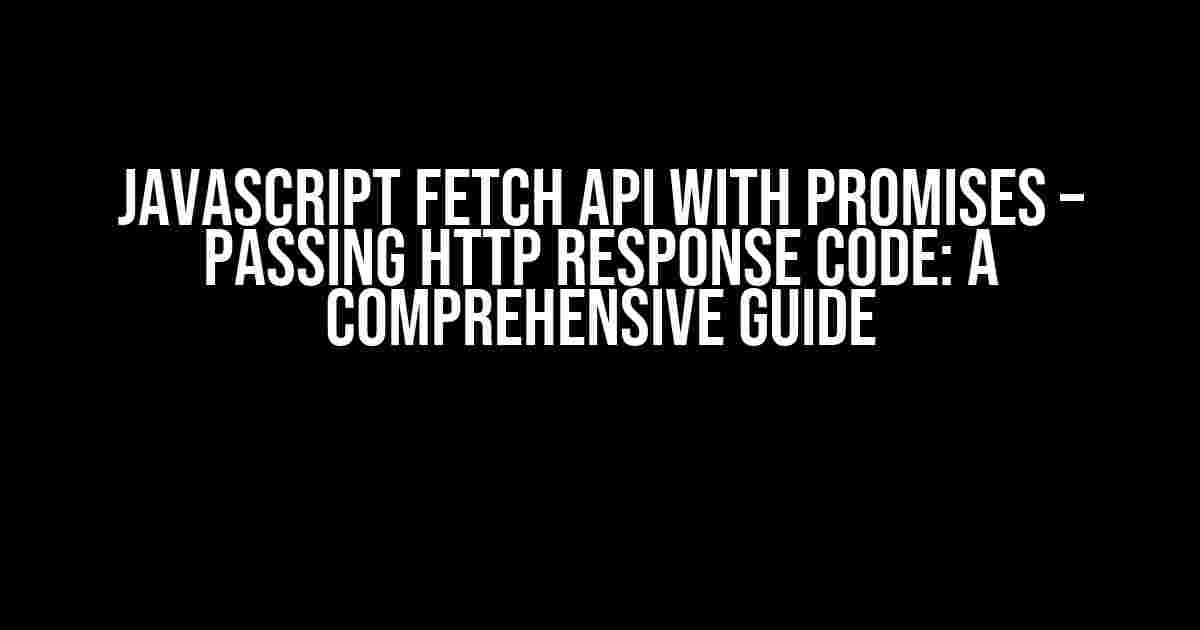Are you tired of dealing with callbacks and confusing asynchronous code in JavaScript? Look no further! In this article, we’ll dive into the world of JavaScript Fetch API with Promises, focusing on passing HTTP response codes. Buckle up, because we’re about to take your JavaScript skills to the next level!
What is the Fetch API?
The Fetch API is a modern replacement for XMLHttpRequest, introduced in 2015. It provides a simple and intuitive way to make HTTP requests from JavaScript, allowing you to fetch resources from the web. The Fetch API returns a Promise, making it easy to handle asynchronous requests.
Why Use the Fetch API?
- Easy to use: The Fetch API has a simple and intuitive syntax, making it easy to make HTTP requests.
- Promise-based: The Fetch API returns a Promise, allowing you to handle asynchronous requests with ease.
- Flexible: The Fetch API can be used for a wide range of HTTP requests, including GET, POST, PUT, and DELETE.
Understanding Promises in the Fetch API
A Promise is a result object that is used to handle asynchronous operations. It represents a value that may not be available yet, but will be resolved at some point in the future. When using the Fetch API, a Promise is returned, allowing you to handle the response data when it becomes available.
fetch('https://api.example.com/data')
.then(response => {
console.log(response);
})
.catch(error => {
console.error(error);
});
Chaining Promises
One of the powerful features of Promises is the ability to chain them together. This allows you to handle the response data in a series of steps, making it easy to parse and process the data.
fetch('https://api.example.com/data')
.then(response => response.json())
.then(data => {
console.log(data);
})
.catch(error => {
console.error(error);
});
Passing HTTP Response Code
When making an HTTP request using the Fetch API, the response object contains an `ok` property, which indicates whether the request was successful. However, what if you need to pass the HTTP response code explicitly? This is where the `status` property comes in.
fetch('https://api.example.com/data')
.then(response => {
if (response.status === 200) {
console.log('Request successful!');
} else {
console.error(`Error: ${response.status}`);
}
})
.catch(error => {
console.error(error);
});
HTTP Response Codes
HTTP response codes are a way to indicate the outcome of an HTTP request. Here are some common HTTP response codes:
| Code | Description |
|---|---|
| 200 | OK – Request successful |
| 404 | Not Found – Resource not found |
| 500 | Internal Server Error – Server error |
| 401 | Unauthorized – Unauthorized access |
Example: Passing HTTP Response Code with Fetch API
Let’s create an example that demonstrates how to pass the HTTP response code using the Fetch API.
fetch('https://api.example.com/data')
.then(response => {
if (response.ok) {
console.log(`Request successful with status code: ${response.status}`);
return response.json();
} else {
throw new Error(`Error: ${response.status}`);
}
})
.then(data => {
console.log(data);
})
.catch(error => {
console.error(error);
});
Handling Errors with Fetch API
When using the Fetch API, it’s essential to handle errors properly. This can be done using the `catch` method, which catches any errors that occur during the request.
fetch('https://api.example.com/data')
.then(response => {
if (response.ok) {
return response.json();
} else {
throw new Error(`Error: ${response.status}`);
}
})
.then(data => {
console.log(data);
})
.catch(error => {
console.error(error);
if (error.name === 'TypeError') {
console.error('Network error occurred');
} else {
console.error(`Error: ${error.message}`);
}
});
Conclusion
In this article, we’ve explored the world of JavaScript Fetch API with Promises, focusing on passing HTTP response codes. We’ve learned how to use the Fetch API to make HTTP requests, handle asynchronous requests with Promises, and pass HTTP response codes explicitly. By following the examples and explanations provided, you’ll be able to create robust and error-free HTTP requests using the Fetch API.
Remember, the Fetch API is a powerful tool that simplifies HTTP requests in JavaScript. By mastering the Fetch API, you’ll be able to create fast and efficient web applications that handle asynchronous requests with ease.
Next Steps
Want to learn more about the Fetch API and JavaScript? Here are some next steps:
Now, go ahead and start building amazing web applications with the Fetch API and JavaScript!
Frequently Asked Questions
Get ready to level up your JavaScript game with our top 5 questions and answers about using the Fetch API with Promises to pass HTTP response codes!
What’s the deal with HTTP response codes in Fetch API?
When you make a request using the Fetch API, the response object contains an ‘ok’ property that indicates whether the response was successful (200-299). You can also access the exact status code using the ‘status’ property. For example, if the server returns a 404 error, the ‘status’ property would be 404.
How do I handle errors with Fetch API and Promises?
When using Fetch API with Promises, you can catch errors using the ‘catch’ method. If the promise is rejected, the ‘catch’ method will be called with the error as an argument. You can also use the ‘finally’ method to perform actions regardless of whether the promise was resolved or rejected.
What’s the difference between ‘ok’ and ‘status’ properties in Fetch API response?
The ‘ok’ property is a boolean that indicates whether the response was successful (200-299), while the ‘status’ property returns the exact HTTP status code. For example, if the server returns a 404 error, ‘ok’ would be false, and ‘status’ would be 404.
Can I use async/await with Fetch API and Promises?
Yes, you can! Async/await is a syntactic sugar on top of Promises, and it makes your code look more synchronous. You can use async/await with Fetch API to write more readable and maintainable code. Just remember to handle errors properly using try-catch blocks.
How do I get the response body using Fetch API?
To get the response body, you need to call the appropriate method on the response object, such as ‘text()’, ‘json()’, or ‘blob()’. For example, if the response body is in JSON format, you would call ‘json()’ to parse it into a JavaScript object.
